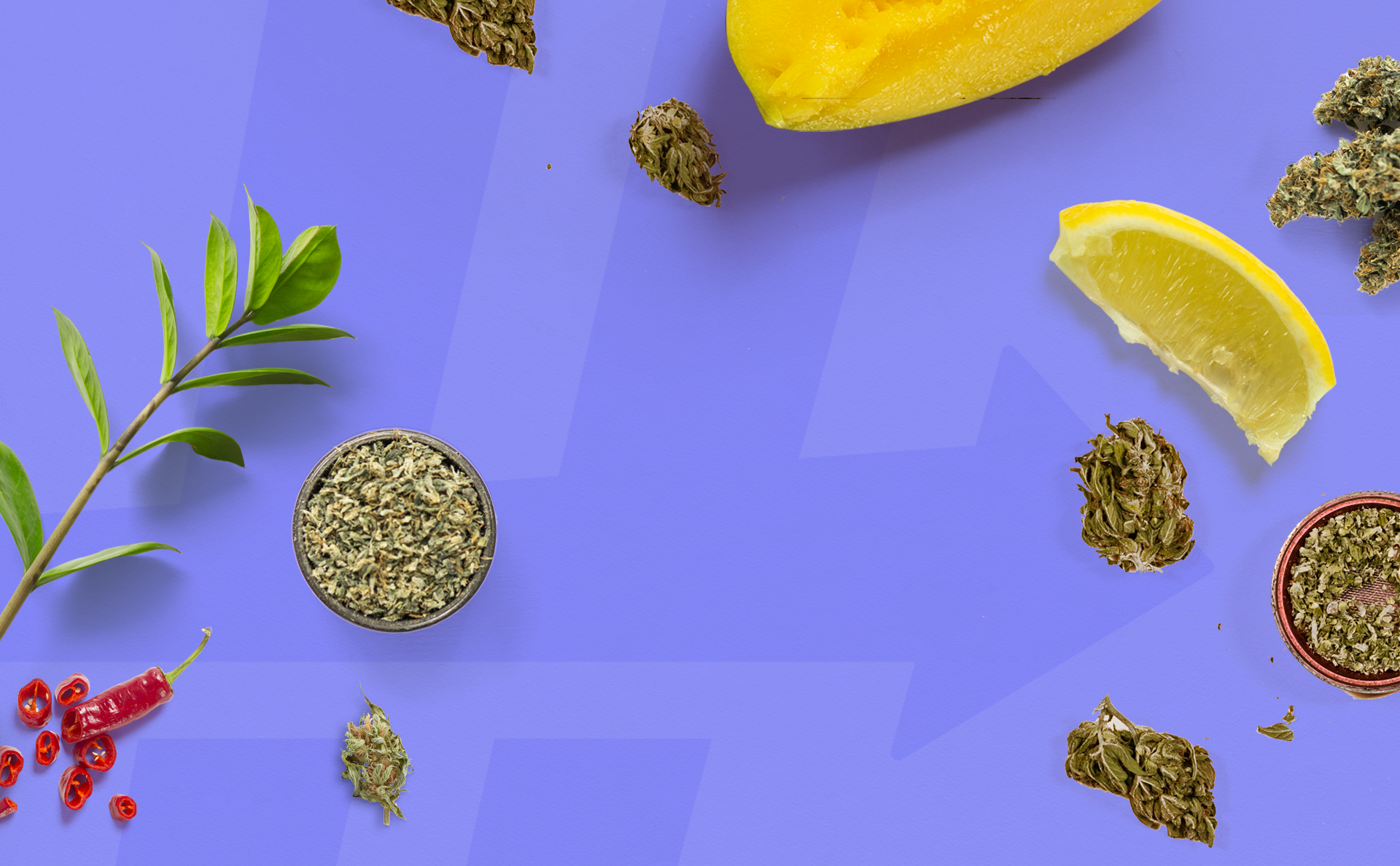What Are Terpenes?
What are terpenes, and how do they impact the cannabis consumption experience? This chapter answers these questions and provides insight into the wonderful world of terpenes.

What are terpenes? This is a valid question that many cannabis consumers ponder, especially those new to cannabis medicine. This introductory chapter explains terpenes and why they’re crucial to cannabis.
Terpenes are organic and fragrant compounds, specifically hydrocarbons, that are large and diverse. Cannabis consumers are likely familiar with terpenes or “terps” because they are rich in the flavors and aromas they add to cannabis varieties.
However, terpenes are a widely complex group of over 80,000 compounds that can be found all over our natural world. They occur naturally in many plants, animals, marine organisms, bacteria, as well as even some insects and fungi.
Some of nature's most commonly abundant, understood, and well-known terps come from trees. In fact, many experts believe that forest trees like conifers contain the most abundant amounts of terpenes of all plants in our natural world. Conifers are typically evergreen trees that produce cones or leaves that are needle-like. These trees include cedars, redwoods, and pine trees.
What Do Cannabis Terpenes Do?
Terpenes function as a specialized form of communication that can attract beneficial organisms, repel harmful ones, and even let plants “talk”. This includes Cannabis, which naturally makes use of all of the above.
Cannabis terpenes may also synergize with cannabinoids. This principle is known as the “entourage effect”. Additionally, terpenes on their own may confer various potential therapeutic benefits used throughout history
For example, pinene is the main terpene behind conifers’ characteristic piney scent, and is also one of the most abundant terpenes on earth. Linalool is another popular terpene found in lavender, basil, and eucalyptus. Both are also in cannabis and may reduce THC’s adverse psychoactive effects and individually have promising potential use for neurological and psychiatric disorders like anxiety, depression, neuropathic pain, and inflammation.
Terpenes can also influence our high, and explain the differences between the old terms “sativa” and “indica”. You may have heard of consumers eating mangoes to get higher off their cannabis. This is because the terpene myrcene, commonly found in mangoes, may help cannabinoids cross the blood-brain barrier and deliver more medicine to the brain where it's needed. It is also sedating, causing “couch lock” and dominates what we colloquially call “indica” strains.
While terpenes aren’t yet known to get people high, there’s groundbreaking research showing certain terpenes may directly hit CB1 at about 10-50% the strength of THC. They may also increase THC’s potency at the CB1 receptor. This new data may redefine the “entourage effect”.
How many terpenes are there in Cannabis?
Common terpenes like pinene, linalool, and over 200 more are also plentifully found across the entire Cannabis species. Plants usually have one or two dominant terpenes, but each cannabis cultivar usually makes around 30–50 terpenes. They are secreted out of the trichomes, the same glands that produce cannabinoids.
By concentration, terpenes account for anywhere from 1-10% of your cannabis’ makeup. Modern selective breeding continues to push up the lower end to around 3.5%. By mass, terpenes are the most abundant compounds in Cannabis adding up to 3-5% of dry weight, weighing even more than all the cannabinoids inside.
We know that terpenes are also responsible for giving cannabis its unique smell and taste, and we can find several main terpene types in each cannabis plant. On average, the dominant terpene in cannabis is about 35% of total terpene content, and the top 4 terpenes account for 72% of the total.

What the expert says...
Dr. Abraham Benavides
"Terpenes are some of the most complex yet misunderstood compounds on the planet. In cannabis, terpenes are responsible for giving cultivars their unique flavor and tastes, as well as potential therapeutic synergies with cannabinoids."
Types of Terpenes Found In Cannabis
Generally speaking, we break down terpenes into two main categories: dominant terpenes, and minor terpenes. In North American Cannabis, the eight most common dominant terpenes found in cannabis include:
We cover all of these dominant terpenes in upcoming chapters of our Terpenes guide.

Minor Terpenes Found In Cannabis
These are just a few examples of the most common terpenes that are found in cannabis. Most cannabis varieties contain more than one terpene, as do many plants in our natural world. Some minor terpenes found in cannabis include:
- Geraniol
- Bisabolol
- Delta-3 Carene
- Borneol
- Camphene
- Terpineol
- Phytol
- Nerolidol
- Sabinene
- Eucalyptol
- Delta-3 carene
These minor terpenes are lesser known because they are not as abundant as major terpenes, but this does not mean they are insignificant. Interestingly, even most of the “dominant” terpenes can be considered minor or even not detectable in different cultivars, or strains.
Benefits of Terpenes In Humans
Terpenes will play a huge role in the future of cannabis medicine and research, as we learn more. Terpenes not only can smell and taste delicious, but they may support cannabinoids and other compounds in the way cannabis makes us feel and its medicinal properties.
We currently don’t know how all the combined essential compounds like terpenes in cannabis impact the effects we feel when consuming it. We also don’t know if terpenes found in the natural world that have proven benefits will translate into those benefits applying to cannabis medicine.
Just like with cannabis, we need large-scale, direct clinical studies to determine whether cannabinoids and terpenes have definitive medicinal benefits on their own or put together. However, recent preclinical data suggests the cannabinoid and terpene synergy is worth continuing to investigate, particularly for conditions such as:
- Pain
- Inflammation
- Anxiety and depression
- Addiction
- Epilepsy
- Cancer
- Bacterial and fungal infections
The truth is that due to the lack of funding and federal illegality of cannabis in the U.S., these anecdotes will remain as such until these studies are finally conducted. For more information on the legalization of cannabis in the U.S., be sure to read our Cannabis Industry guide.
What We Learned: What Are Terpenes?
As we learned in this chapter, the wonderful natural world of terpenes is as interesting as they are diverse. If you’d like to dig deeper into terpenes, be sure to read on to our next chapters or check out the Terpene Spotlight articles on our blog.
We believe that terpenes hold the key to better understanding the complexly amazing cannabis plant. Here’s what we learned in this chapter:
- Terpenes are a large and diverse group of organic compounds, specifically hydrocarbons.
- Most cannabis consumers know about terpenes, but they exist in many plants, animals, and even fungi in our natural world.
- Experts believe that forest trees like conifers contain the most abundant amounts of terpenes of all plants in our natural world.
- Terpenes can influence our high. They aren’t proven to get us high, but certain terpenes may directly hit cannabinoid receptors weakly and increase THC’s effects.
- Myrcene may increase cannabinoid delivery to the brain, sedate you, and increase your high. It may cause the “couch lock” that indica fans enjoy.
- Contrarily, pinene can decrease the high and increase focus and short-term memory instead. Found in popular sativa cultivars like Sour Diesel.
- Commonly dominant terpenes include caryophyllene, humulene, limonene, linalool, myrcene, ocimene, pinene, and terpinolene.
- Terpenes have been shown to provide some potential benefits when extracted and studied from other plants. This does not mean that these benefits translate into cannabis, because the terpene content of these studied plants is different from that of cannabis.
- Although terpenes are understudied, we know that these compounds are responsible for giving cannabis its unique smell and taste, and we can find several main terps in cannabis.
We recommend you check out the rest of our chapters in the Cannabis Basics guide before digging deeper into building your knowledge of cannabis.
If you've done some of this digging already and are eager to get started learning about specific terpenes, answer the question below, and let's keep learning.
Citations
- Chacon, F. T., Raup-Konsavage, W. M., Vrana, K. E., & Kellogg, J. J. (2022). Secondary Terpenes in Cannabis sativa L.: Synthesis and Synergy. Biomedicines, 10(12), 3142.https://doi.org/10.3390/biomedicines10123142
- Liktor-Busa, E., Keresztes, A., LaVigne, J., Streicher, J. M., & Largent-Milnes, T. M. (2021). Analgesic Potential of Terpenes Derived from Cannabis sativa. Pharmacological Reviews, 73(4), 1269–1297.https://doi.org/10.1124/pharmrev.120.000046
- Raz, N., Eyal, A. M., Zeitouni, D. B., Hen-Shoval, D., Davidson, E. M., Danieli, A., Tauber, M., & Ben-Chaim, Y. (2023). Selected cannabis terpenes synergize with THC to produce increased CB1 receptor activation. Biochemical Pharmacology, 212, 115548.https://doi.org/10.1016/j.bcp.2023.115548
- Russo, E. B. (2019). The Case for the Entourage Effect and Conventional Breeding of Clinical Cannabis: No “Strain,” No Gain. Frontiers in Plant Science, 9.https://doi.org/10.3389/fpls.2018.01969
- Sommano, S. R., Chittasupho, C., Ruksiriwanich, W., & Jantrawut, P. (2020). The Cannabis Terpenes. Molecules, 25(24), 5792.https://doi.org/10.3390/molecules25245792
- Surendran, S., Qassadi, F., Surendran, G., Lilley, D., & Heinrich, M. (2021). Myrcene—What Are the Potential Health Benefits of This Flavouring and Aroma Agent? Frontiers in Nutrition, 8, 699666.https://doi.org/10.3389/fnut.2021.699666
- Weston-Green, K., Clunas, H., & Jimenez Naranjo, C. (2021). A Review of the Potential Use of Pinene and Linalool as Terpene-Based Medicines for Brain Health: Discovering Novel Therapeutics in the Flavours and Fragrances of Cannabis. Frontiers in Psychiatrhttps://doi.org/10.3389/fpsyt.2021.583211
Test your knowledge, track your progress and earn your badge.
Which of the following do experts believe contains the most abundant amounts of plant terpenes in our natural world?

Dr. Abraham Benavides
Dr. Abraham Benavides is an internationally-recognized cannabis research expert, experienced medical advisor, and full-tuition merit scholar of the George Washington University School of Medicine and Health Sciences. Dr. Abe enjoys helping patients as a writer, educator, and cannabis health coach at the GW Center for Integrative Medicine.